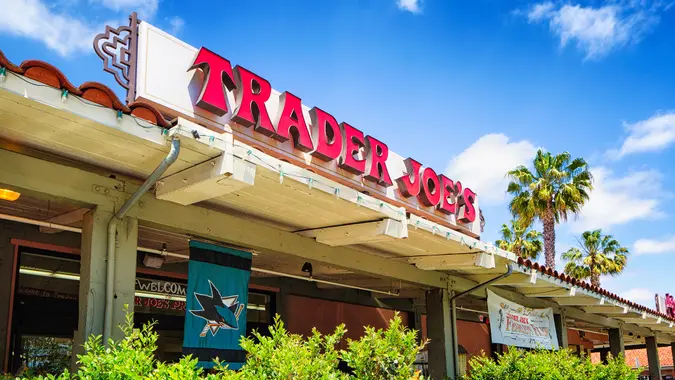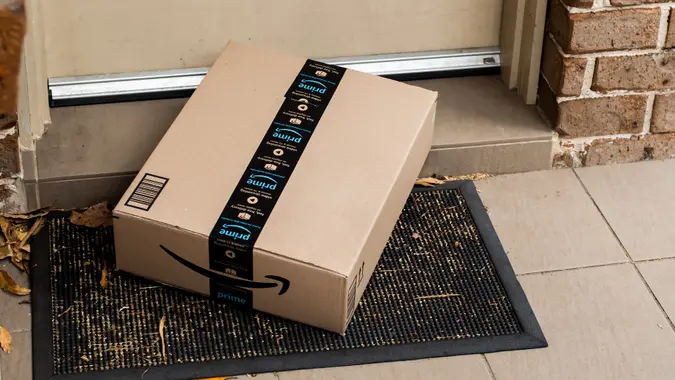10 States Where You Pay Taxes on Groceries

Commitment to Our Readers
GOBankingRates' editorial team is committed to bringing you unbiased reviews and information. We use data-driven methodologies to evaluate financial products and services - our reviews and ratings are not influenced by advertisers. You can read more about our editorial guidelines and our products and services review methodology.

20 Years
Helping You Live Richer

Reviewed
by Experts

Trusted by
Millions of Readers
In 2024, Oklahoma eliminated its sales tax on food and food ingredients, according to Oklahoma Tax Commission. In 2025, Kansas followed suit, per the Kansas Office of the Governor. Both policy shifts were part of a years-long pattern.
Kiplinger reported that the states have trended toward ending their sales tax for grocery purchases, reducing it or offsetting it with tax credits since 2020, when the Center on Budget and Policy Priorities urged more states to join the 33 (including Washington, D.C.) that gave their residents a tax-free supermarket experience.
However, the below 10 states still levy at least some sales tax on grocery purchases.
Alabama
Alabama recently passed legislation that lowered its sales tax on groceries from 3% to 2%, according to the state’s official website. It’s scheduled to take effect on Sept. 1.
Arkansas
In April, Arkansas Gov. Sarah Huckabee signed a bill that eliminated the state’s 0.125% tax on grocery sales, per its official website. The Grocery Tax Relief Act goes into effect on Jan. 1, 2026.
Hawaii
According to Kintsugi, Hawaii doesn’t levy a direct sales tax, but its general excise tax adds 4% to the cost of most services and products, including groceries — and some counties tack on an additional 0.5% surcharge. However, a tax credit tied to income offsets some of the burden for qualified residents.
Idaho
Idaho levies its full 6% sales tax on groceries, one of the highest in the nation, according to Idaho Education News. However, a tax credit averaging $120 per person allows individuals to enjoy tax-free food shopping on $2,000 worth of purchases, per Idaho State Tax Commission.
Illinois
In 2024, Illinois House Bill 3144 ended the state’s 1% grocery tax, which was already markedly lower than its 6.5% general sales tax, per the Illinois General Assembly. The repeal takes effect on Jan. 1, 2026, but the legislation allows counties to impose their own 1% tax on grocery receipts, according to Avalara.
Mississippi
Mississippi residents recently got some relief from paying one of the highest supermarket surcharges in America when lawmakers lowered the state’s grocery tax from 7% to a still-bruising 5%, per the Mississippi Department of Revenue. The City of Moss Point, Mississippi’s website states the reduction went into effect on July 1.
Missouri
Missouri taxes groceries at a reduced rate of 1.225%, 3% lower than its 4.225% general sales tax, according to Zamp. However, the reduced rate applies only to all SNAP-eligible purchases.
South Dakota
A ballot bill called Measure 28 would have exempted grocery purchases from South Dakota’s 4.2% sales tax, which is slated to return to 4.5% in 2027, as reported by South Dakota Public Broadcasting (SDPB). However, the state’s official website shows voters overwhelmingly rejected the measure on Nov. 6, 2024.
Tennessee
Depending on where they live, some Tennesseeans pay one of the highest grocery taxes in the nation, according to the state’s official website. Although, per Wate 6 News, the state recently lowered it by 20% from 5% to 4%, local taxes can push it up to the 7% that Mississipians paid until recently — or even more.
Utah
Utah levies a combined 3% sales tax on groceries, per Hands Off Sales Tax (HOST). It’s the combination of a 1.75% state sales tax and a 1.25% local tax.
More From GOBankingRates
- Nearly 1 in 3 Americans Hit by a Costly Holiday Scam, Norton Survey Shows -- How To Avoid This
- Here's What the Average Social Security Payment Will Be in Winter 2025
- How Middle-Class Earners Are Quietly Becoming Millionaires -- and How You Can, Too
- The Easiest Way to Score $250 for Things You Already Do
 Written by
Written by  Edited by
Edited by 

























